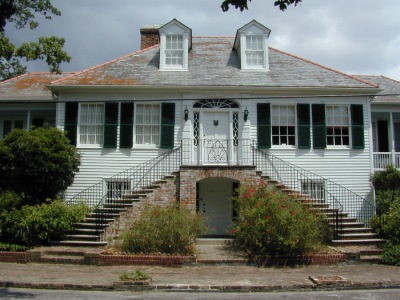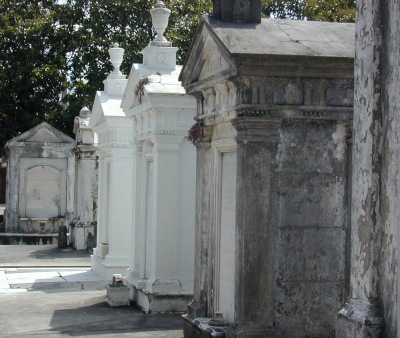Lady with a pink parasol
One of the things in New Orleans that Dorte wanted to
see, was the Garden District. It is the oldest American part of town, and is
characterized by rather large mansions. When the U.S. took control of the
Louisiana Territory in 1803, a few Americans moved to New Orleans, but they were
not very popular with the French and Spaniards who were the dominant population
groups, so these groups wouldn't allow them to settle in the French Quarter.
Many
americans therefore settled on old plantation land west of the city, and it was
this area, that was later to become Garden District.
When we took our swamp tour the day before we had seen
that you could buy a guided walking tour of Garden District. But this time we
wasn't fooled into taking a bus from the hotel. We drove ourselves and parked
the car on one of the major car parks, and bought the ticket at the ticket
office. Again, we were transported by bus to our
destination on St. Charles Avenue, where the walking tour would begin. We were
around 12 people taking the walking tour and when we got of the bus, we met by our
guide. She was a lady around 60. She was dressed in a pink
outfit, and armed with a parasol in the same color. She introduced herself as
"Miss Katie" and Dorte and I were convinced that she was a retired primary
school teacher, not least because she constantly addressed everyone as "children".
"Come on children" and "Listen carefully now children" were two of her preferred
terms.
Miss Katie started the tour with a presentation of the
program. First, we should see a rather large mansion with inside access. Then we
were going to visit a small shop where we could get something to drink and where
we, especially the women, could use "the little potty room" as Miss Katie put
it. When this was over we would then continue around to some other selected
houses and there would also be a visit to one of New Orleans' interesting
cemeteries before we wouild return to to the bus.
 With
Miss Katie and her parasol in the lead, we hurried down the street to the Elms
Mansion, the first house on the list. When everyone had seen enough, we
went on to the little shop where there actually turned out to be tables and
chairs. Here we were ordered to sit down after having had the opportunity to buy
drinks, and visit "the little potty room". Then Miss Katie ordered: "Silence
children" and then she started to tell us about the city, not least of course
Garden District. Like so many other guides, we have encountered in different
cities, there was no doubt that she loved her city.
With
Miss Katie and her parasol in the lead, we hurried down the street to the Elms
Mansion, the first house on the list. When everyone had seen enough, we
went on to the little shop where there actually turned out to be tables and
chairs. Here we were ordered to sit down after having had the opportunity to buy
drinks, and visit "the little potty room". Then Miss Katie ordered: "Silence
children" and then she started to tell us about the city, not least of course
Garden District. Like so many other guides, we have encountered in different
cities, there was no doubt that she loved her city.
After the lecture we continued through the district and
saw many beautiful houses, among others, the oldest house in Garden Distrrict
which was built in 1834. We also saw several houses equipped with "pettticoat
staircases". It was a double staircase where the men could go up along one side,
while women could climb the other. This way the men didn't happen to see the
womens legs, which would have meant a great deal of trouble. Take your pick. A
duel with an angry husband or father or maybe a marriage if the woman was
unmarried.
One of the other houses we saw was built by er rich
merchant for his daughter when she got married to make sure she would have something
to live in. This fact gave rise to a rather amusing conversation between us who
was on the tour. One of the male participants explained that it was not much
different today. You would also see parents finance their children's homes. We
explained that even in Denmark there were many parents who bought property for
their children so that they could get something to live in. This made one of the
female tour guests, a lady in her late 30'es that obviously was on vacation with
her teenage son and her mother, to exclaim that she didn't understand why. She
was sure that, in Europe the whole family lived together in one room. We tried
to convince her otherwise, but she found it very hard to believe that we were
only two people in our house.
Well, we continued the tour and passed the awful turquopise
colored building, that houses the world famous Commander's Palace restaurant. Miss Katie told
an anecdote about how one time, when there was fire in the building, the first
object to be rescued by the firefighters was the bowl of turtle soup.
 The
last place we visited on the tour was the cemetery Lafayette no. I. It is near
the center of Garden District, and is typical of New Orleans' cemeteries. At
Lafayette no. I four types of tombs is used. First, high tombs with
room for two, low tombs with room for one, and temporary graves found in the
wall around the cemetery. Also a few large mausoleum type of tombs. The
tombs are owned by families, and they can be traded as any other real estate and
to surprisingly high prices.
The
temperature inside the tombs will get so high from the sun, that a natural
cremation will take place and a tomb can be reused a year and a day after a
burial. At the doors of tombs you can see the names of all those who over time
are buried in the tomb, and when a plate is filled up, it is moved to the side
of the tomb and a new door plate put in. This way you can follow the history of
the tomb and see how it may have changed ownership along the way. Miss Katie
told us that her mother had just bought a grave in the cemetery and that she had
agreed with the previous owners that the ashes of their relatives would be left in the bottom of the grave. Alternatively, you can agree about
transfering it to a tomb in the wall, but most buyers it will leave it in the
tomb out of respect for the deceased that was buried in the tomb before they bought
it.
The
last place we visited on the tour was the cemetery Lafayette no. I. It is near
the center of Garden District, and is typical of New Orleans' cemeteries. At
Lafayette no. I four types of tombs is used. First, high tombs with
room for two, low tombs with room for one, and temporary graves found in the
wall around the cemetery. Also a few large mausoleum type of tombs. The
tombs are owned by families, and they can be traded as any other real estate and
to surprisingly high prices.
The
temperature inside the tombs will get so high from the sun, that a natural
cremation will take place and a tomb can be reused a year and a day after a
burial. At the doors of tombs you can see the names of all those who over time
are buried in the tomb, and when a plate is filled up, it is moved to the side
of the tomb and a new door plate put in. This way you can follow the history of
the tomb and see how it may have changed ownership along the way. Miss Katie
told us that her mother had just bought a grave in the cemetery and that she had
agreed with the previous owners that the ashes of their relatives would be left in the bottom of the grave. Alternatively, you can agree about
transfering it to a tomb in the wall, but most buyers it will leave it in the
tomb out of respect for the deceased that was buried in the tomb before they bought
it.
After visiting the cemetery we walked back toward the
bus. Along the way we passed a very large house with a very large car outside.
The house belonged to the writer Anne Rice, best known for her novels about the
vampire Lestat, but she has also written other horror stories. Under the
pseudonyms Anne Rampling and the A. C. Roquelaure, she has written some pretty
boring erotic novels. As the trip neared its end, Miss Katie said that she would
understand completely, if our holiday budget did not include tips to guides, and that she would love us all anyway, but that those who gave tips she would love
even more, and after this speech, who could avoid adding a little extra tip for
her :-)
When we got back to the French Quarter, we went for a
walk along the Mississippi once again. Here we passed the river boat Cajun
Queen, that was about to take off. We therefore decided to take a trip with it
and see New Orleans from the riverside. The trip lasted for approx. 1 ˝
hours, of which 20 minutes went by sailing down the river and the rest to sail
back toward the current. A nice trip, were we learned even more about New
Orleans and its history.
When we got back to town
again, we were a little hungry, and on Decatur, we found a fish restaurant, that
looked interesting. Dorte ordered gumbo, a soup of Cajun / Creole origin, which
can contain almost anything, from fish to chicken to meat - and also a lot of
vegetables. The waiter warned her though that their gumbo was not to good
on that particular day, so he recommended her to try something else. I don't
remember what she got, but I chose the
grilled catfish. I think
we were forgotten once we had ordered, as it lasted almost 30 minutes before
the waiter returned with our drinks, and another 45 minutes before we got our
lunch. But when we got it, it tasted very good.
After lunch we continued down Decatur to Jackson Brewery, formerly a brewery
like the name suggests, but now a mall with shops, restaurants etc, quite
similar to the Riverwalk. At Jackson Square,
which is the central square in the French Quarter, there was some carriages
pulled by mules, that took tourists for a ride :-).
Once again we decided to go for it. The
Coachman told us about the neighborhood, "Le Vieux Carré" as the French call it,
and especially on how to save money, so when the tour was over, he argued that
some of the money he had saved us, we should spend on tips for him.
- Return to Anniversary tour -
- Return to
Travel Stories -